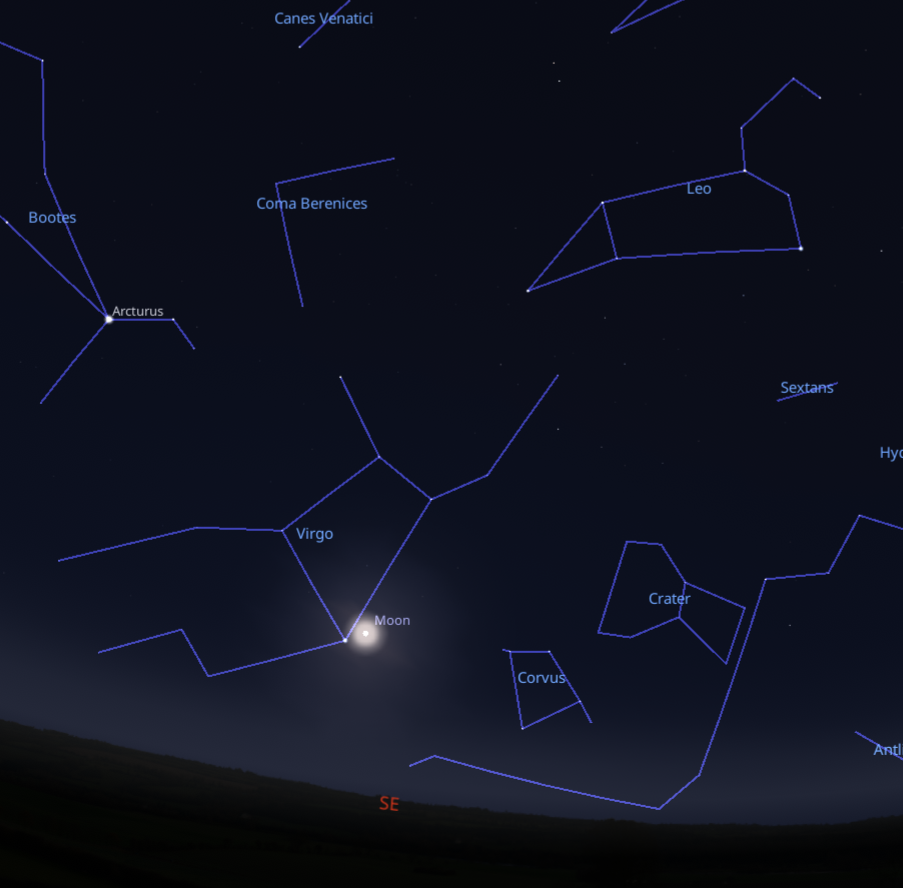April is a great month for stargazing in Ireland. The nights are getting shorter, with the sun setting just after 8 pm at the start of the month, and just before 9 pm at the end of the month. There will still be plenty of time for stargazing though, and hopefully some better weather for doing so. This month brings good opportunities to spot galaxies, watch a meteor shower, and catch a bright full moon. Here’s what to look out for in the night sky this April.
The Planets
We will have plenty of opportunities to observe the planets this month, with Jupiter and Mars visible every evening, and Venus showing itself for a short time in the mornings before sunrise.
Jupiter
Jupiter will be the first to appear every evening in the west just after sunset. Find it in the constellation of Taurus, the bull, just above its central ‘V’ shape with the bright star Aldebaran. Jupiter will slowly leave our night sky over the next few months as it gets closer to the Sun every evening from our perspective here on Earth, so find it while you can.
Mars
Mars can be found higher up and to the left of Jupiter within the constellation of Gemini, the twins. Gemini contains two bright stars, Pollux and Castor, that represent the heads of the twins, and Mars will be just below them. On the 5th of April the Moon will pass close by Mars.
The moon passing by Mars in Gemini on April 5th and Jupiter’s location in Taurus. Image credit: Stellarium.
Venus
Just before sunrise every morning, around 6 am, look east towards the horizon to spot Venus, which is currently our morning star. Venus is quite close to the Sun, so you won’t have long to observe it before the Sun’s light gets in the way.
Notable Constellations
Leo – The Lion
Leo is high in the southern sky during April evenings. It’s best viewed from 9 PM onward, reaching its highest point around midnight. Look for a distinctive backward question mark shape — that’s the lion’s head, with the bright star Regulus at the base. This is a great area for galaxy hunting. With binoculars or a small telescope, you can spot Messier galaxies like M65, M66, and M95 near Leo’s “belly.”
Virgo – The Maiden
Virgo follows Leo across the sky, rising in the southeast in the evening. Look for the bright bluish-white star Spica, Virgo’s brightest star, which helps anchor the constellation’s fainter stars. Virgo is home to the Virgo Cluster of galaxies — a rich field of distant galaxies that’s ideal for telescopes under dark skies. The Moon will pass close by Spica on April 12th.

The moon passing by Spica in Virgo on April 12th. Image credit: Stellarium.
April’s Full Moon
On April 12th, we will be treated to a full moon rising in the east just before 9 pm. It will be located right next to Spica. This won’t be the best day for stargazing because the full moon’s light will be very bright and make fainter objects hard to see, but a full moon is always amazing to observe. This year our April full moon is also the Paschal Full Moon, the moon that determines the date of Easter Sunday. The Paschal Full Moon is the first full moon on or after the Spring Equinox on March 21st, and Easter Sunday is the first Sunday after the Paschal Full Moon. There will then be a New Moon on April 29th, so take the opportunity to do some stargazing while the sky is as dark as it can be.
Lyrid Meteor Shower
The Lyrids meteor shower is one of the oldest known meteor showers, with our earliest known sighting occurring in 687 BC by Chinese astronomers. Look towards the east/northeast, to the constellation Lyra, the harp, which is where the radiant point of the meteor shower is. You will typically see 10-20 meteors per hour at the shower’s peak, which is April 21st – 22nd, but occasionally we can have a very active year with as many as 100 meteors per hour. This constellation is easily spotted because it contains Vega, one of the brightest stars in the night sky. The radiant point is the area of sky in which meteors seem to originate from, but make sure you look all around the sky to catch these meteors as they streak past. Find a comfortable spot away from light pollution, lie back, and allow your eyes to adjust to the dark for about 30 minutes for the best viewing experience. I would also recommend wrapping up to keep warm. This is not the most active meteor shower, but we won’t have any interference from the Moon, so hopefully we get a good showing if the nights are clear.
Hubble Space Telescope 35th Anniversary
You may have heard a lot recently about the James Webb Space Telescope, but its predecessor is celebrating its 35th anniversary this month. On the 24th of April 1990, the Hubble Space Telescope was launched into orbit. Hubble has helped scientists measure the rate of the universe’s expansion, discover exoplanets, and observe galaxies billions of years old. Orbiting above Earth’s atmosphere, it captures incredibly detailed images of distant galaxies, nebulae, and stars, free from atmospheric distortion. Its data has contributed to thousands of scientific papers and brought space closer to the public through its stunning imagery.
Wishing you starry skies!
Blog post written by Jane Dooley



